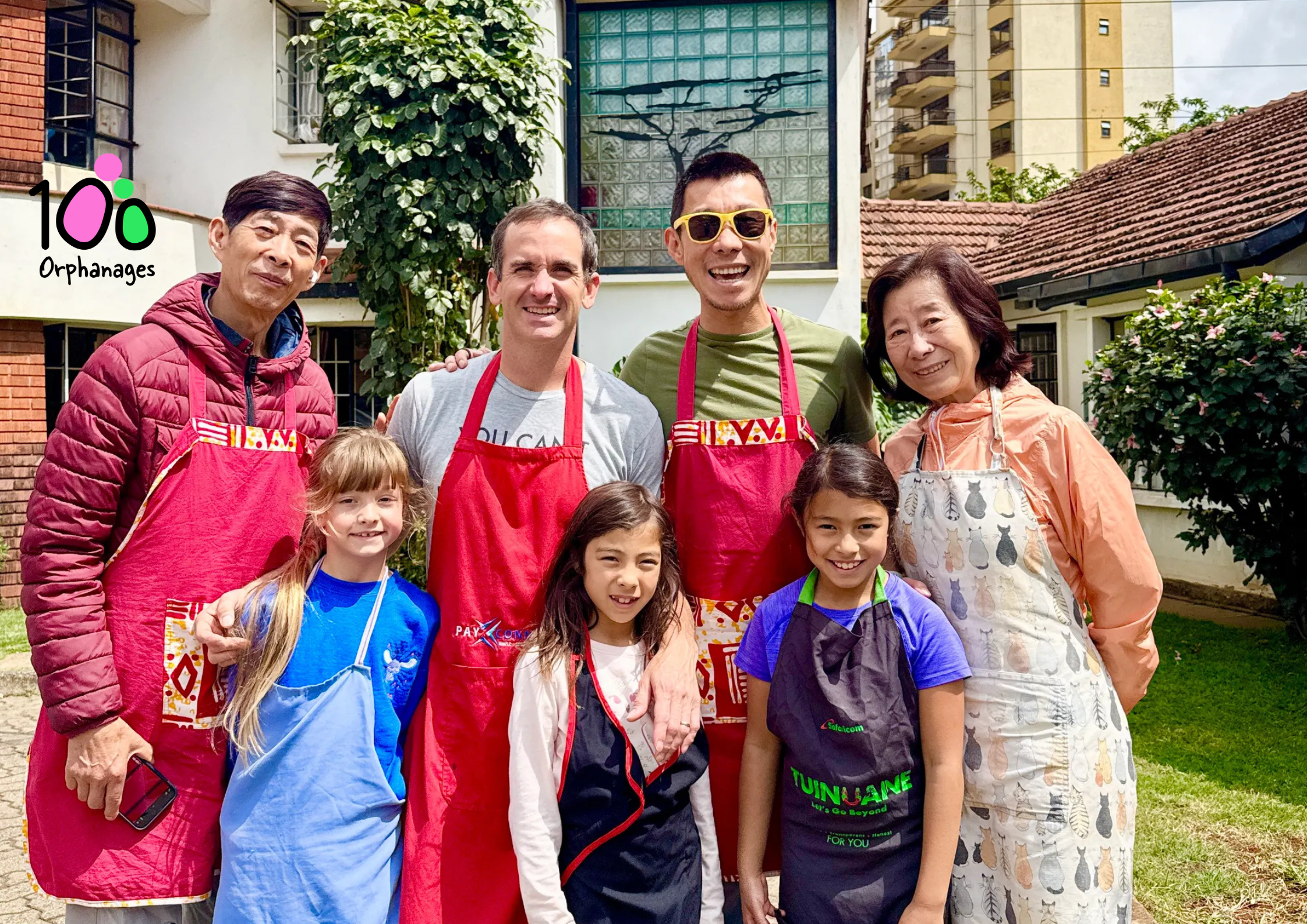When our family travels each year to volunteer at an orphanage, it’s not “voluntourism.” It’s a promise we made to ourselves—and to our kids—to spend time serving, learning, and remembering how fortunate we are. Our daughters were born in America. I wasn’t. I grew up in China, and that contrast is never lost on me. I want our children to see with their own eyes that kindness is a verb, not an idea, and that their small, daily acts can lift someone else’s whole world.
This year, we spent a week at New Life Home Trust in Nairobi, Kenya—a place that left us humbled, inspired, and full of hope.
What We Found at New Life: Order, Dignity, and Deep Care
From the moment we walked through the gate of New Life’s Kilimani home, we felt the difference: calm, clean rooms; clear routines; and caregivers who knew every child by name, temperament, and needs. New Life was founded in 1994 to rescue and care for abandoned and extremely vulnerable babies, with the goal of placing them in loving families whenever possible. Today, the Trust continues that mission across Kenya through a network of homes and programs dedicated to rescue, high-quality care, and family placement. NewLife Home Trust
The Nairobi home itself is carefully organized into four units—Isolation & Special Care, Baby Unit, Crawlers, and Toddlers—with age-appropriate environments and routines in each. The home primarily rescues children 0–6 months old and can host up to 52 children. Seeing that structure in action—care plans, feeding schedules, play blocks, and rest—helped us understand why New Life runs so smoothly and why children there thrive. NewLife Home Trust
Beyond Nairobi, New Life operates four baby rescue centres in Kenya—Nairobi, Nyeri, Nakuru, and Kisumu—with the capacity to care for up to ~150 babies and toddlers at any time across the homes. Older children who are not adopted live in family-style houses overseen by housemothers, with tailored support (including for special needs). Charity Commission
What also stood out: New Life’s homes are more than shelters; they function with the rigor of medical settings when needed. The Nairobi and Kisumu homes hold dual registration as Charitable Children’s Institutions and Private Medical Centres, which allows them to care for very vulnerable infants with the medical attention they require. NewLife Home Trust
A Day in the Life of Volunteers
We were assigned to stations and rotated through the day—exactly what a well-run home should do with volunteers. Our mornings often began in the infant unit, feeding babies for the first hour and a half. There’s something sacred about a bottle, a warm blanket, and a steady heartbeat against your shoulder. After cleanup, we moved to the older kids outside, where the yard came alive: balls, blocks, ride-on toys, and so much giggling. Later we returned indoors to help prepare and feed nutritious meals—simple food, thoughtfully planned.
Everything had a purpose. Everything was on time. And at every station, the staff set the tone with patience and dignity. As Dale Carnegie might say, we were encouraged to “become genuinely interested” in each child—notice the shy ones, praise a tiny milestone, and meet each little person where they were. That approach doesn’t just keep a home running; it builds trust.
The Moment That Changed Us: A Family Is Born
Mid-week, something extraordinary happened—two children were adopted. We even had the honor of quietly observing one of the ceremonies: singing, dancing, a welcome that felt as old as the land and as new as a child’s first homecoming. There was cake, there were tears, and there was that feeling you get only when a door swings open to a different future.
In that moment, our girls saw exactly why places like New Life matter. An orphanage is not the destination; it’s a bridge to family. And the better the bridge—the stronger the care, the better the resources, the clearer the process—the more children cross it.
New Life’s impact is real and measurable. Since its founding, the organization has rescued more than 2,550 babies, and approximately 85% have been placed in loving families through reunification, fostering, or adoption. Those aren’t just numbers; they are names, birthdays, first steps, and second chances. NewLife Home Trust
Why This Model Works
Over the years, we’ve visited different children’s homes around the world. Each has unique strengths, and each is navigating complex realities. With New Life, several practices stood out that we believe are worth sharing widely:
- Triage + Specialized Care: New Life prioritizes the most vulnerable babies (often 0–6 months), many with medical needs. The home’s medical capability—paired with structured units—creates stability and safety from day one. NewLife Home Trust
- Consistent Routines: Predictable schedules (feeding, play, rest) reduce stress for babies and staff. Volunteers are assigned roles that support—not disrupt—care plans.
- Family Placement as a North Star: Every practice points toward permanency. The goal isn’t simply “care”—it’s family. NewLife Home Trust
- A Network, Not an Island: Four baby rescue centres offer regional coverage and shared standards. Older children who aren’t adopted live in family-style homes with housemothers, keeping a “family feel” at the center. Charity Commission
One note of context that surprised many of our U.S. friends: Kenya currently has an indefinite moratorium on intercountry adoptions. That reality makes local family placement, kinship care, and reunification even more important—and New Life is built for that. NewLife Home Trust
What Our Kids Learned (And What We Did Too)
Our daughters learned that “helping” isn’t glamorous—it’s a lot of small, ordinary things done with care: washing hands the right way, sanitizing bottles, resetting a play space, eating together without hurrying, and showing up on time. They learned to notice: who needs a quieter corner, who needs a cheering “you’ve got this!” for their first wobbly steps, who needs a nap more than a toy.
They also learned about joy—the everyday kind. The joy of a baby finishing a full bottle. The joy of a toddler’s proud, sticky smile after lunch. The joy of caregivers who celebrate small wins like major holidays.
And then there was that adoption ceremony. Watching a child welcomed home—truly home—taught our kids more about love and commitment than any talk ever could.
Why “100 Orphanages”?
People sometimes ask why our family started the vision we call “100 Orphanages.” The honest answer is that children’s needs are diverse, and one model can’t meet them all. Across our travels, we’ve seen:
- Homes that act like emergency rooms for infants and toddlers
- Programs supporting teen moms and their babies
- Transitional homes focused on adolescents who are aging out, where the danger isn’t just “where will I sleep?” but “will I have to marry simply to survive?”
Different needs demand different answers. Our hope is to learn from many models—including New Life—and then share those best practices across a global network so that each home can adapt what works locally. We want to be a platform and a think tank where directors, caregivers, social workers, and volunteers teach each other what moves the needle for kids.
In practical terms, that means elevating examples like New Life’s:
- Regional coverage with shared standards
- Medical capacity for the most vulnerable
- Systems that point every child toward a permanent family whenever possible
By learning from homes like this—and supporting others to adapt similar practices—we move closer to a world where every child grows up in a family, not in an institution.
What We’ll Carry Forward
We left New Life with gratitude and a clear conviction: well-run homes make adoption (and family reunification) more likely. Good care builds healthy children; healthy children find families faster. It’s that simple—and that profound.
We also left with a list of “little things” that aren’t little at all:
- Structure is love you can feel. Routines become a language of safety.
- Nutrition is non-negotiable. Good food, on time, changes outcomes.
- Play is serious work. The right toys and outdoor time build bodies, brains, and bonds.
- Volunteers support, staff lead. The best volunteers take direction well and add energy without adding friction.
A Personal Thank-You
To the New Life team: thank you for trusting us with a week inside your world. The way you combine competence with compassion sets a standard. You showed our kids what professionalism looks like when the “job” is love. And to the families who welcomed children home while we were there: we will remember your songs and your courage for the rest of our lives.
How You Can Help (Wherever You Are)
You don’t have to fly to Nairobi to make a difference. Here are a few meaningful ways to stand with children:
- Support organizations that prioritize family placement. New Life’s track record—2,550+ babies rescued and ~85% placed in loving families—shows what’s possible when permanency is the goal. NewLife Home Trust
- Give to medical and nutrition funds. These dollars are small hinges that swing big doors for infants.
- Share know-how. If you’re a pediatric nurse, social worker, educator, therapist, or operations leader, your expertise can help a home run better.
- Champion local fostering and adoption where you live. Children everywhere need families, and your advocacy matters.
Closing: The Promise We’re Making
We came to Kenya to serve. We left with a renewed promise: to keep building a network where homes learn from homes, where best practices travel faster than problems, and where every child has a real shot at joining a family.
Every home we help is a step toward that future. Thank you, New Life Home Trust, for reminding us what’s possible when care is excellent, systems are strong, and love has a plan.
Notes & Sources:
New Life’s mission and history; total babies rescued and percentage placed with families; and the list of Kenyan home locations/capacities are drawn from New Life’s official site and public filings. See New Life’s History and Homes pages for current figures and home details, and New Life Home Trust UK’s Trustees’ Annual Report for network capacity and locations. Kenya’s policy context regarding intercountry adoption is summarized in New Life’s FAQ. NewLife Home Trust+2NewLife Home Trust+2Charity Commission

